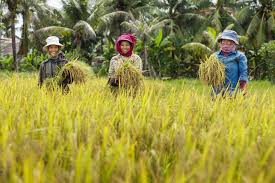
Food Security and Nutrition in Cambodia



| Climate Change | Climate Change Impact to Agriculture Sector In Cambodia |
|---|---|
 |
The impact of climate change on agriculture in Cambodia The agriculture sector is extremely vulnerable to the increase in temperatures, change in rainfall pattern, extreme weather events such as cyclones, drought and flooding as well as sea-level rise in coastal areas[2]. Drought: drought often happens because of global warming that has caused an increased in temperature and the lack of rainfall[3]. Increasing in temperature is a problem that led to dry condition and decrease in crop production, leaving negative impacts on human, animals and particularly agriculture sector and food security. From 2009 to 2013 Cambodia has suffered from drought annually, affecting around 7.8 million people. In 2015 and 2016 Cambodia experienced drought linked to the effect of the El Nino climate cycle which decreased rainfall and increased heat; it negatively affected rice yields and irrigation demand. In the same years the effect caused harm to 2.5 million people and 235,000 hectares of land. In 2018 drought affected about 20,000 hectares of rice fields and 19,000 hectares of land[4]. Rising sea level: The sea level is estimated to increase from 16cm by 2030 up to 45cm by 2070[5]. The rapid rise causes saline intrusion of drinking water and fresh water ecosystem, invade costal area and reduce agricultural land. Flood: Cambodia experienced the worst floods so many times, and over 200,000 to 244,000 hectares of rice fields were lost. https://cpsa-growasia.org/en/climate-change-and-sustainable-agriculture-in-cambodia/ |
 |
By 2030, all Cambodians will have access to healthy diets and safe food, with an initial focus on women and children, to break the intergenerational cycle of malnutrition and address the nutrition transition. Food systems will nourish Cambodia’s population, strengthen local production and distribution, generate domestic and international opportunities for trade and enterprise, offer equitable livelihoods especially for youth, be resilient to vulnerabilities, shocks and stresses, steward the environment, and help mitigate and adapt to climate change by shifting the food system towards green growth.https://summitdialogues.org/wp-content/uploads/2021/09/FS-Roadmap_Cambodia_Final-for-submission-1.pdf |
 |
Cambodia has witnessed significant economic transformation in recent years. However, progress remains fragile, challenged by geographical and gender disparities, as well as vulnerability to shocks – including climate-related disasters that can undo years of developmental gains. A substantial portion of the population still faces food insecurity, poverty and shocks. Malnutrition rates are high, with 10 percent of children below 5 suffer from wasting (low weight for height) and 22 percent experiencing stunting (impaired development), while micronutrient deficiency and overweight/obesity are on the rise. Despite these challenges, the Government of Cambodia has set an ambitious goal of middle-income status by 2030 and high-income status by 2050, by sustaining growth and accelerating structural transformation. To support the above goal, Cambodia’s sustainable development relies on eradicating malnutrition, enabling all people to reach their full potential and being resilient in the face of shocks.https://www.fao.org/faolex/results/details/en/c/LEX-FAOC152419/ |
| Description for video 3. | |
 |
Description for image 4. |
| Description for video 4. | |
 |
Description for image 5. |
| Description for video 5. |